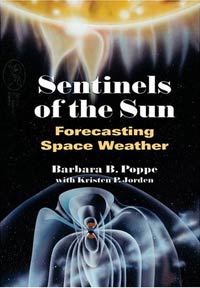Review: Sentinels of the Sunby Jeff Foust
|
| Perhaps the most interesting chapter, though, is the discussion on the long battle to maintain federal funding for the SEC and its predecessor organizations. |
The book doesn’t dwell much on the science of space weather: while there is some discussion of sunspots and solar flares, the book lacks any deep scientific discussion about what causes these and other solar phenomena, and what they tell us about the nature of the Sun. The book instead focuses on the effects of space weather, including the broad array of people affected by solar storms. While the effects of solar weather on radio propagation and satellites are well known, a wide array of other fields also pay attention to solar weather, from airlines (to avoid radio blackouts on long flights over the North Pole, as well as concerns about radiation exposure) to oil pipeline operators (because geomagnetic storms can induce current in long pipelines, causing electrical interference and even corrosion) and even pigeon racers (pigeons can become disoriented, it turns out, when a solar storm disrupts the Earth’s magnetic field.)
Perhaps the most interesting chapter, though, is the discussion on the long battle to maintain federal funding for the SEC and its predecessor organizations. On several occasions funding for the office was in jeopardy because of Congressional budget cuts or simple oversights. The SEC also had a long battle with local officials in Boulder, Colorado to get a new headquarters building constructed in the 1990s, after it had outgrown an aging building next door; the city forced a number of design concessions on the building to ensure that it fit into the landscape and did not block the view of the mountains from a nearby street. Ironically, the authors note, “The beauty of the new building perhaps caused a congressional staffer who visited it in 2002 to resent NOAA… Presumably too much money had been spent on this excessively nice facility.” This has led to an odd battle over the last several years to win full funding for the SEC, an office that, fully funded, requires approximately $7 million a year: the final fiscal year 2006 appropriations bill included only about $4 million for the SEC, even though the House and Senate had previously approved larger amounts, for reasons that even many in Congress don’t understand. How much money the SEC will get in the upcoming fiscal year remains to be determined.
There are a few flaws in Sentinels of the Sun: in addition to the lack of detailed scientific discussion about what generates solar activity, the book could have used another round of copy editing and fact checking (there are several minor errors in dates in the book, and Europe’s Galileo satellite navigation system is referred to as “Galaxy” instead). Overall, though, the book offers an interesting introduction to the reasons why space weather is important, and what has been done to date to study it. It may be enough to persuade an educated layman, otherwise unaware of space weather, to not take the Sun for granted in the future.
